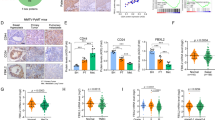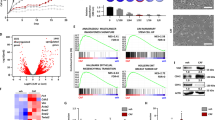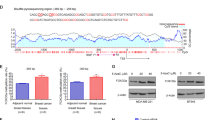Abstract
B-cell lymphoma/leukemia 10 (BCL10) is an apoptotic regulatory protein related to advanced TNM stage and disease recurrence in oral squamous cell carcinoma (OSCC). However, the regulatory mechanism of BCL10 in OSCC progression is still unknown. Here, we showed that knockdown of endogenous BCL10 could significantly reduce cell migration and invasion abilities, retard cell proliferation by G0/G1 phase accumulation and inhibit tumorigenicity in vivo. In molecular level, we identified S100P as a crucial downstream effector of BCL10-inhibited OSCC progression by high-throughput microarray analysis. S100P messenger RNA and protein expression levels were significantly diminished in silenced-BCL10 clones, and transfected S100P expression plasmids restored migration, invasion, proliferation abilities and tumorigenicity in shBCL10 transfectants. Furthermore, we provided evidence that BCL10 regulated S100P expression through signal transducers and activators of transcription 1 (STAT1) and activating transcription factor 4 (ATF4). Knockdown of BCL10 decreased S100P promoter activity, but showed no effect in truncated STAT1/ATF4 S100P promoter. In addition, we also found that the P50/P65 signaling pathway was involved in BCL10-enhanced OSCC progression. Restored S100P in silenced-BCL10 clones could markedly reverse P65 activation via outside-in signaling. Taken together, we discovered a novel axis of BCL10-regulated OSCC progression via STAT1/ATF4/S100P/P65 signaling, which could predict the prognosis of OSCC and will be beneficial for developing therapeutic strategy against advanced OSCC.
This is a preview of subscription content, access via your institution
Access options
Subscribe to this journal
Receive 50 print issues and online access
$259.00 per year
only $5.18 per issue
Buy this article
- Purchase on Springer Link
- Instant access to full article PDF
Prices may be subject to local taxes which are calculated during checkout









Similar content being viewed by others
References
Vokes EE, Weichselbaum RR, Lippman SM, Hong WK . Head and neck cancer. New Engl J Med 1993; 328: 184–194.
Haddad RI, Shin DM . Recent advances in head and neck cancer. New Eng J Med 2008; 359: 1143–1154.
Parkin DM, Bray F, Ferlay J, Pisani P . Global cancer statistics, 2002. CA Cancer J Clin 2005; 55: 74–108.
Negri E, La Vecchia C, Franceschi S, Tavani A . Attributable risk for oral cancer in northern Italy. Cancer Epidemiol Biomarkers Prev 1993; 2: 189–193.
Boyle P, Veronesi U, Tubiana M, Alexander FE, da Silva F, Denis LJ et al. European School of Oncology Advisory report to the European Commission for the ‘Europe Against Cancer Programme’ European Code Against Cancer. Eur J Cancer 1995; 31A: 1395–1405.
Wutzl A, Ploder O, Kermer C, Millesi W, Ewers R, Klug C . Mortality and causes of death after multimodality treatment for advanced oral and oropharyngeal cancer. J Oral Maxillofac Surg 2007; 65: 255–260.
Gupta GP, Massague J . Cancer metastasis: building a framework. Cell 2006; 127: 679–695.
Willis TG, Jadayel DM, Du MQ, Peng H, Perry AR, Abdul-Rauf M et al. Bcl10 is involved in t(1;14)(p22;q32) of MALT B cell lymphoma and mutated in multiple tumor types. Cell 1999; 96: 35–45.
Lee SH, Shin MS, Kim HS, Park WS, Kim SY, Lee HK et al. Point mutations and deletions of the Bcl10 gene in solid tumors and malignant lymphomas. Cancer Res 1999; 59: 5674–5677.
Holzmann K, Kohlhammer H, Schwaenen C, Wessendorf S, Kestler HA, Schwoerer A et al. Genomic DNA-chip hybridization reveals a higher incidence of genomic amplifications in pancreatic cancer than conventional comparative genomic hybridization and leads to the identification of novel candidate genes. Cancer Res 2004; 64: 4428–4433.
Yeh PY, Kuo SH, Yeh KH, Chuang SE, Hsu CH, Chang WC et al. A pathway for tumor necrosis factor-alpha-induced Bcl10 nuclear translocation. Bcl10 is up-regulated by NF-κB and phosphorylated by Akt1 and then complexes with Bcl3 to enter the nucleus. J Biol Chem 2006; 281: 167–175.
Wang D, You Y, Lin PC, Xue L, Morris SW, Zeng H et al. Bcl10 plays a critical role in NF-κB activation induced by G protein-coupled receptors. Proc Natl Acad Sci USA 2007; 104: 145–150.
Jiang T, Grabiner B, Zhu Y, Jiang C, Li H, You Y et al. CARMA3 is crucial for EGFR-Induced activation of NF-κB and tumor progression. Cancer Res 2011; 71: 2183–2192.
Martin D, Galisteo R, Gutkind JS . CXCL8/IL8 stimulates vascular endothelial growth factor (VEGF) expression and the autocrine activation of VEGFR2 in endothelial cells by activating NFκB through the CBM (Carma3/Bcl10/Malt1) complex. J Biol Chem 2009; 284: 6038–6042.
Chang HH, Kuo MY, Cheng SJ, Chiang CP . Expression of BCL10 is significantly associated with the progression and prognosis of oral squamous cell carcinomas in Taiwan. Oral Oncol 2009; 45: 589–593.
Klemm S, Zimmermann S, Peschel C, Mak TW, Ruland J . Bcl10 and Malt1 control lysophosphatidic acid-induced NF-κB activation and cytokine production. Proc Natl Acad Sci USA 2007; 104: 134–138.
Arumugam T, Simeone DM, Schmidt AM, Logsdon CD . S100P stimulates cell proliferation and survival via receptor for activated glycation end products (RAGE). J Biol Chem 2004; 279: 5059–5065.
Taguchi A, Blood DC, del Toro G, Canet A, Lee DC, Qu W et al. Blockade of RAGE-amphoterin signalling suppresses tumour growth and metastases. Nature, 2000; 405: 354–360.
Huttunen HJ, Fages C, Kuja-Panula J, Ridley AJ, Rauvala H . Receptor for advanced glycation end products-binding COOH-terminal motif of amphoterin inhibits invasive migration and metastasis. Cancer Res 2002; 62: 4805–4811.
Hayden MS, Ghosh S . Shared principles in NF-κB signaling. Cell 2008; 132: 344–362.
Hacker H, Karin M . Regulation and function of IKK and IKK-related kinases. Sci STKE 2006; 2006: re13.
McAllister-Lucas LM, Ruland J, Siu K, Jin X, Gu S, Kim DS et al. CARMA3/Bcl10/MALT1-dependent NF-κB activation mediates angiotensin II-responsive inflammatory signaling in nonimmune cells. Proc Natl Acad Sci USA 2007; 104: 139–144.
Bhattacharyya S, Gill R, Chen ML, Zhang F, Linhardt RJ, Dudeja PK et al. Toll-like receptor 4 mediates induction of the Bcl10-NFκB-interleukin-8 inflammatory pathway by carrageenan in human intestinal epithelial cells. J Biol Chem 2008; 283: 10550–10558.
Donato R . S100: a multigenic family of calcium-modulated proteins of the EF-hand type with intracellular and extracellular functional roles. Int J Biochem Cell Biol 2001; 33: 637–668.
Salama I, Malone PS, Mihaimeed F, Jones JL . A review of the S100 proteins in cancer. Eur J Surg Oncol 2008; 34: 357–364.
Cancemi P, Di Cara G, Albanese NN, Costantini F, Marabeti MR, Musso R et al. Large-scale proteomic identification of S100 proteins in breast cancer tissues. BMC Cancer 2010; 10: 476.
Yao R, Davidson DD, Lopez-Beltran A, MacLennan GT, Montironi R, Cheng L . The S100 proteins for screening and prognostic grading of bladder cancer. Histol Histopathol 2007; 22: 1025–1032.
Diederichs S, Bulk E, Steffen B, Ji P, Tickenbrock L, Lang K et al. S100 family members and trypsinogens are predictors of distant metastasis and survival in early-stage non-small cell lung cancer. Cancer Res 2004; 64: 5564–5569.
Bertram J, Palfner K, Hiddemann W, Kneba M . Elevated expression of S100P, CAPL and MAGE 3 in doxorubicin-resistant cell lines: comparison of mRNA differential display reverse transcription-polymerase chain reaction and subtractive suppressive hybridization for the analysis of differential gene expression. Anticancer Drugs 1998; 9: 311–317.
Guerreiro Da Silva ID, Hu YF, Russo IH, Ao X, Salicioni AM, Yang X et al. S100P calcium-binding protein overexpression is associated with immortalization of human breast epithelial cells in vitro and early stages of breast cancer development in vivo. Int J Oncol 2000; 16: 231–240.
Averboukh L, Liang P, Kantoff PW, Pardee AB . Regulation of S100P expression by androgen. Prostate 1996; 29: 350–355.
Shedden K, Taylor JM, Enkemann SA, Tsao MS, Yeatman TJ, Gerald WL et al. Gene expression-based survival prediction in lung adenocarcinoma: a multi-site, blinded validation study. Nat Med 2008; 14: 822–827.
Shyu RY, Huang SL, Jiang SY . Retinoic acid increases expression of the calcium-binding protein S100P in human gastric cancer cells. J Biomed Sci 2003; 10: 313–319.
Logsdon CD, Simeone DM, Binkley C, Arumugam T, Greenson JK, Giordano TJ et al. Molecular profiling of pancreatic adenocarcinoma and chronic pancreatitis identifies multiple genes differentially regulated in pancreatic cancer. Cancer Res 2003; 63: 2649–2657.
Sato N, Hitomi J . S100P expression in human esophageal epithelial cells: human esophageal epithelial cells sequentially produce different S100 proteins in the process of differentiation. Anat Rec 2002; 267: 60–69.
Parkkila S, Pan PW, Ward A, Gibadulinova A, Oveckova I, Pastorekova S et al. The calcium-binding protein S100P in normal and malignant human tissues. BMC Clin Pathol 2008; 8: 2.
Whiteman HJ, Weeks ME, Dowen SE, Barry S, Timms JF, Lemoine NR et al. The role of S100P in the invasion of pancreatic cancer cells is mediated through cytoskeletal changes and regulation of cathepsin D. Cancer Res 2007; 67: 8633–8642.
Koltzscher M, Neumann C, Konig S, Gerke V . Ca2+-dependent binding and activation of dormant ezrin by dimeric S100P. Mol Biol Cell 2003; 14: 2372–2384.
Austermann J, Nazmi AR, Muller-Tidow C, Gerke V . Characterization of the Ca2+ -regulated ezrin-S100P interaction and its role in tumor cell migration. J Biol Chem 2008; 283: 29331–29340.
Acknowledgements
This work was supported by grants from National Science Council, Taiwan NSC-100-2314-B-002–097 (to C-CC), NSC-101–2314-B-002–102 (to H-HC).
Author information
Authors and Affiliations
Corresponding author
Ethics declarations
Competing interests
The authors declare no conflict of interest.
Additional information
Supplementary Information accompanies this paper on the Oncogene website
Rights and permissions
About this article
Cite this article
Wu, TS., Tan, CT., Chang, CC. et al. B-cell lymphoma/leukemia 10 promotes oral cancer progression through STAT1/ATF4/S100P signaling pathway. Oncogene 34, 1207–1219 (2015). https://doi.org/10.1038/onc.2014.43
Received:
Revised:
Accepted:
Published:
Issue Date:
DOI: https://doi.org/10.1038/onc.2014.43
This article is cited by
-
Identification of oral cancer related candidate genes by integrating protein-protein interactions, gene ontology, pathway analysis and immunohistochemistry
Scientific Reports (2017)
-
Transcriptomic characterization of differential gene expression in oral squamous cell carcinoma: a meta-analysis of publicly available microarray data sets
Tumor Biology (2016)
-
The pleiotropic effects of fisetin and hesperetin on human acute promyelocytic leukemia cells are mediated through apoptosis, cell cycle arrest, and alterations in signaling networks
Tumor Biology (2015)



